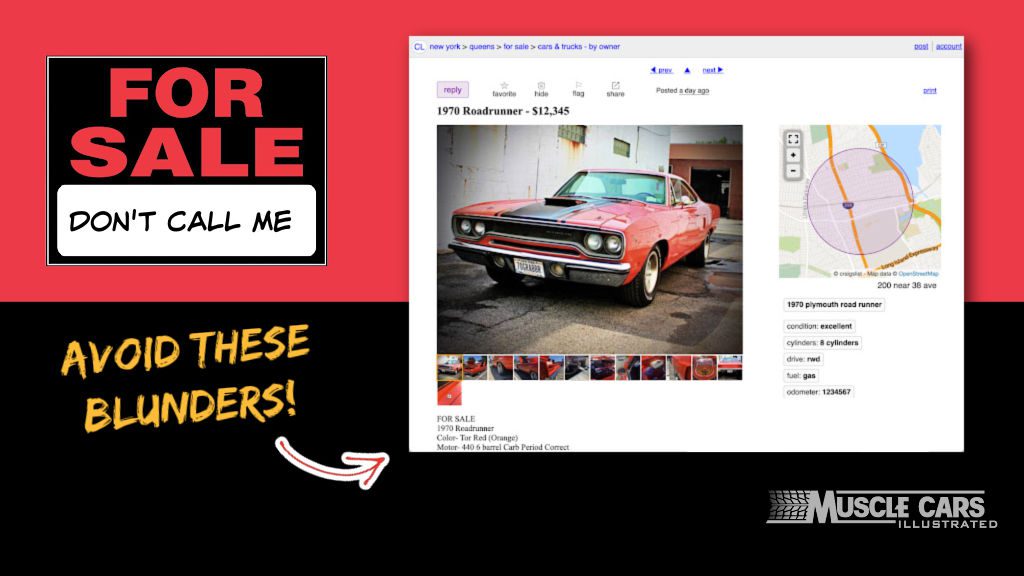
If you’re selling your classic muscle car, one of your first moves is to post a classified ad on eBay, Craigslist, Hemmings, or Facebook Marketplace.
However, many sellers make the mistake of leaving out critical photos and details that help build the most value and attract the right buyer.
When you post a classified ad without much effort, it takes longer to sell the vehicle, but it can also reduce your chances of getting top dollar.
Let’s look at ten classified ad blunders to avoid when selling a muscle car, shall we?
Table of Contents
Classified Ad Listing Blunders to Avoid
Here are ten frequently made blunders that you’ll find over and over again on online classified ad listings for classic muscle cars. Do the opposite to produce a better classified ad!
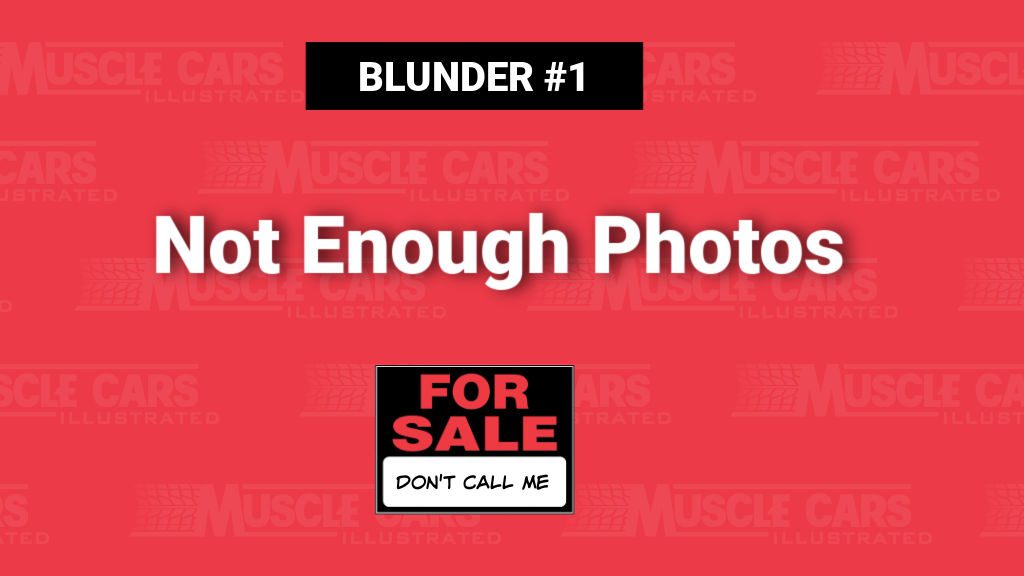
Not Enough Photos
Having the right photos of your muscle car for sale will help do a lot of your selling and is equally as important as the details you provide.
Some would argue that photos are more important than the details.
The truth is, both photos and details are equally important if you want to sell your classic muscle car.
So, to that end, it’s in your best interest to upload the right pictures buyers are looking for to help attract the right buyer.
The primary aim of the photos is to clearly show all of the major angles of the vehicle so buyers can see important details, including:
- What’s present
- What’s missing
- What’s original
- What’s modified
- Dents, dings, and chips
- Cracks and tears
- Rust holes
- Condition of the paint
- Condition of the bumpers
- Condition of the lenses
- Condition of the glass
- Etc.
So, what photos must you include above all others?
Here are the bare minimum eight essential photos of your vehicle you must include in every classified ad listing if you want it to sell faster.
| Photo | Instructions |
|---|---|
| 1. Front | Standing directly in front of the vehicle, photograph the car’s entire front end so that nothing is cut off from view. |
| 2. Driver’s Side | Standing directly to the side of the driver’s door, step away far enough to capture the entire vehicle from the front bumper to the rear bumper. Use this image as the primary photo in the listing. |
| 3. Rear | Standing directly behind the vehicle, take a photo of the car’s entire back end so that nothing is cut off from view. |
| 4. Passenger Side | Standing directly to the side of the passenger’s door, step away far enough to capture the entire vehicle from the front bumper to the rear bumper |
| 5. Engine Compartment | With the hood open, take a photograph of the entire engine compartment while standing directly in front of the engine bay. The engine compartment doesn’t need to be detailed—just show it for what it is. |
| 6. Interior | With the passenger’s door open, take a photo of the entire front end of the cabin, including the front seats, shifter, radio, steering wheel, and dashboard. |
| 7. Trunk | After removing all debris from the trunk, take a picture of the entire trunk compartment. NOTE: Show the sheet metal’s condition no matter how rusty it is—buyers want to see it! |
| 8. Tags | Take a picture of the vehicle’s cowl, fender, or door jam tag. Assuming one is still present, this helps the buyer identify what original options the vehicle came with from the factory and builds value into the vehicle. |
Where to look for the tags:
- GMs have a metal stamped tag on the driver’s side cowl (firewall).
- Fords have a metal stamped tag in the driver’s side door jam.
- AMCs have a decal in the driver’s side door jam.
- Mopars have a metal fender tag on the driver’s side inner fender.
- Mopars also have a decal in the driver’s side door jam.
While there are more photos you should consider, these eight will put you ahead of most classified ads and can provide enough information to prospective buyers to spark more inquiries.
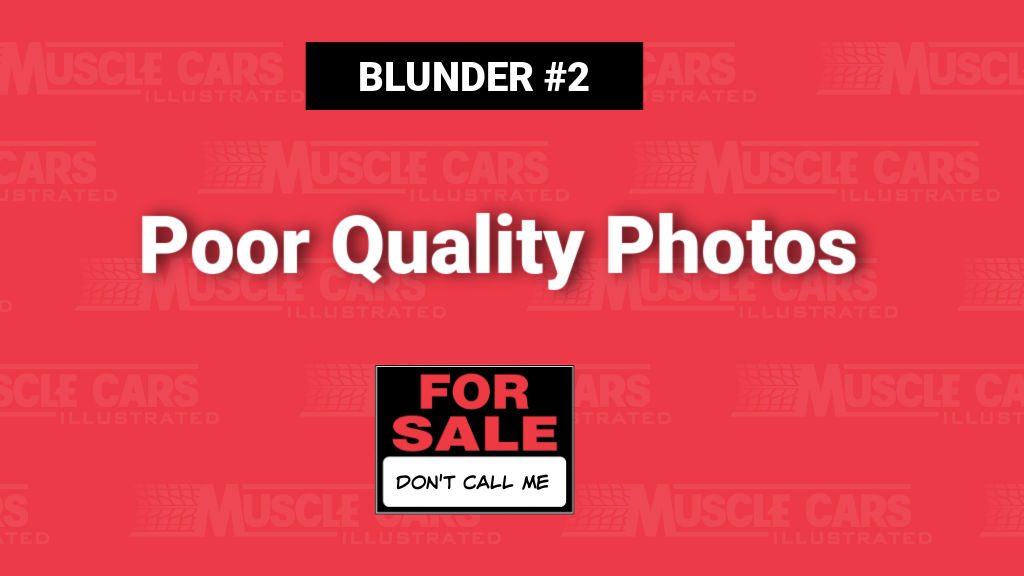
Poor Quality Photos
Nothing is more frustrating than bad photos in a classified ad, regardless of its condition.
One of the biggest mistakes people make is uploading poor-quality photos that are blurry, cropped, hide details, cover up flaws, and omit critical features buyers want to see.
It’s not enough to provide the eight photos above: they must also be of higher quality.
Tips For Better Photos
- Take photos outdoors just before sun up or sundown.
- Make the car the star of the picture, not the supporting actor.
- Keep your fingers out of sight.
- Photos should be crisp, not blurry.
- Don’t park the car under any strong shadows.
- Remove any visual distractions from view.
- Stand as close as you can to the car while keeping the entire automobile in the frame.
Being mindful of the photos you upload will go a long way to help sell your vehicle.
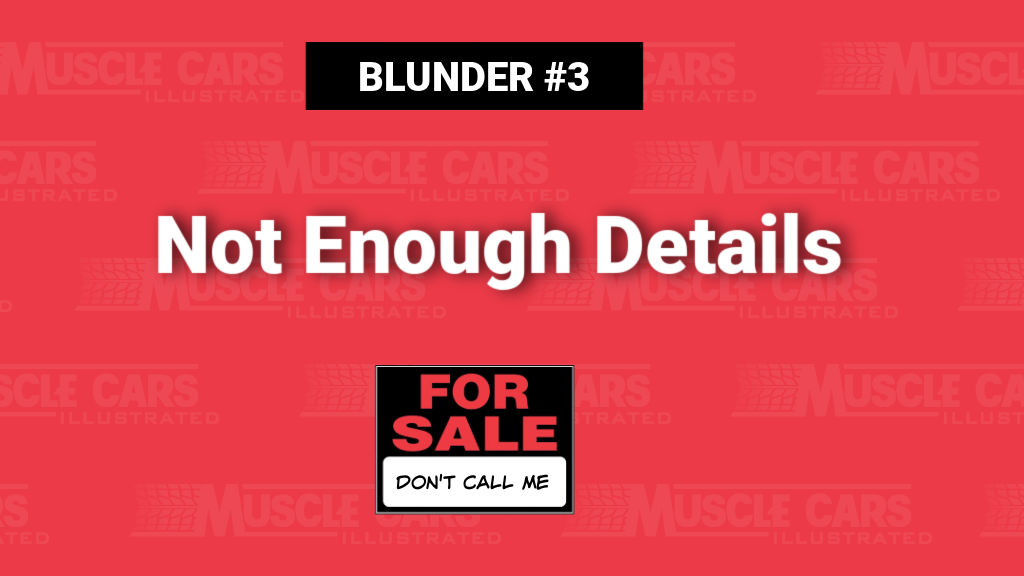
Not Enough Details
As is often said, “The Devil is in the details.”
There is a difference between providing details and providing the correct details.
You don’t want to write a novel but instead, provide the right amount of details to sell your muscle car as fast as possible. Some people accomplish this in bullet points, while others write it all out.
Either way, what should you include?
Here you should include the good, the bad, and the ugly.
Here are some essential details you must include in your classified listing if you want to lure in prospective buyers.
Details To Include
- Year, make, and model.
- Color of the exterior.
- Color of the interior.
- Engine displacement.
- Transmission type (manual vs automatic).
- The number of gears in the transmission.
- Condition of the vehicle (Restored, survivor, etc.).
- How much you’re asking.
- The location of the vehicle.
- The true and accurate mileage/odometer reading—if known.
- If it has the original engine and transmission.
- If it comes with any extra parts.
- If it runs and drives.
- The last time it was registered.
- How original it is.
- What’s been modified.
- What’s missing.
- Why you’re selling it.
- The forms of payment you’ll accept.
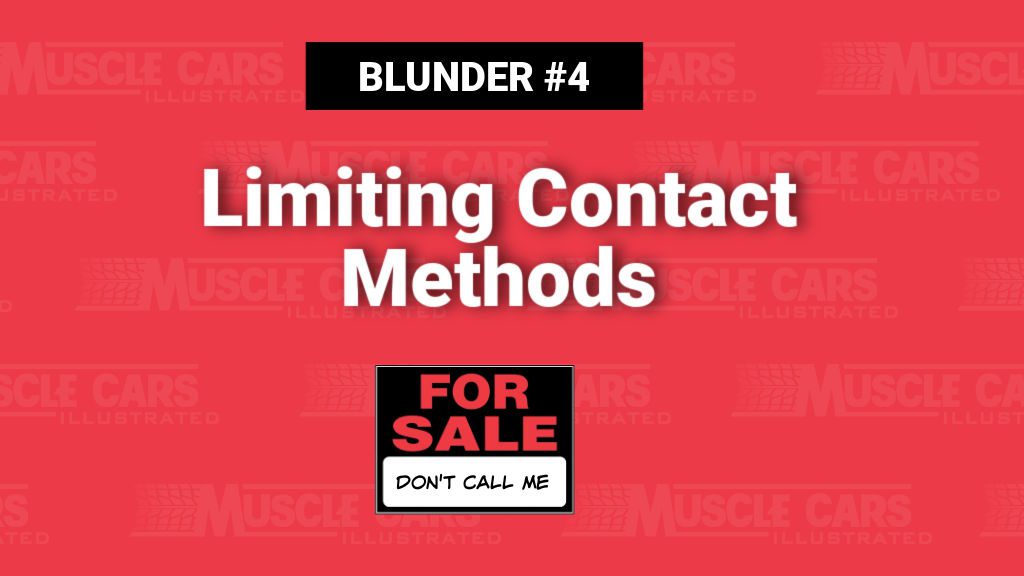
Limiting Contact Methods
Just because you’re selling an old school muscle car doesn’t mean you have to be old school in how you let people contact you.
If you’re modern enough to sell your vehicle online, you need to be modern enough to use the basic forms of electronic communication that come with posting online.
The whole point of your classified ad is to get prospective buyers to contact you so you can sell your muscle car as fast as possible.
However, many sellers make it challenging to reach them, often limiting the methods, days, and times people can reach them.
Allow people to call, text, and email you to attract a wider variety of people who might not want to talk over the phone.
If you’re not available on certain days and times, people will just leave a voicemail. Don’t put the burden on them to wait to contact you. The longer they wait, the less likely they are to call.
While accepting texts and emails might not be the most convenient for you, it is for them, and they are the ones who want to give you money.
If you can’t accept text because your phone doesn’t handle text messaging or it’s not part of your data plan, that’s another story.
The point is if you genuinely want to sell your classic muscle car, allow prospects to contact you how they want and when they want to help bring you the most leads possible.
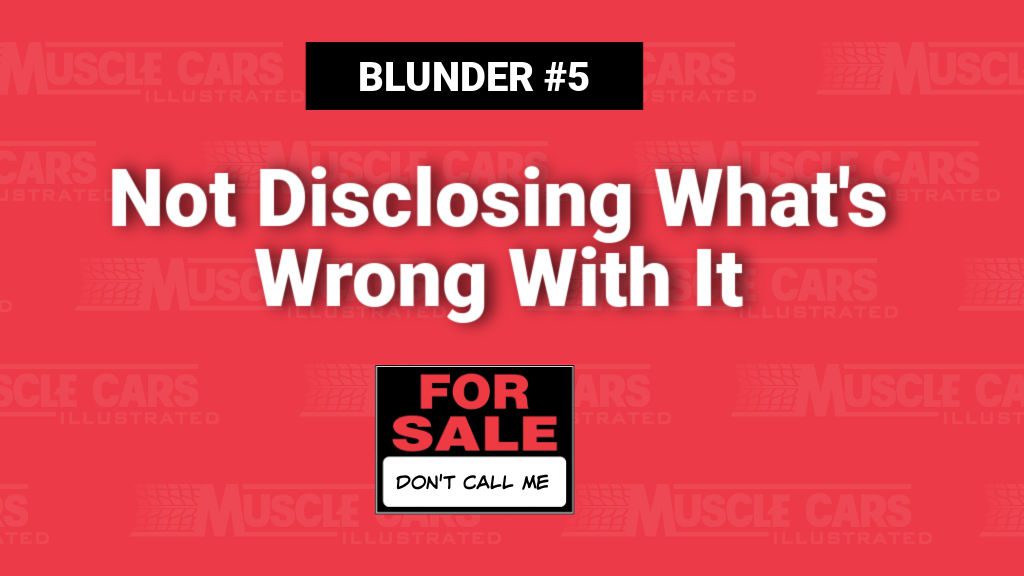
Not Disclosing What’s Wrong With It
Look, no one likes surprises.
Whether in photos or descriptions, prospective buyers want to know about rust, collision damage, engine failures, broken transmissions, leaks, electrical issues, etc.
You’re wasting everyone’s time if you withhold vital details that you’ll only reveal once someone either shows up or discovers for themselves.
Either way, it erodes trust and confidence in you as the seller. It also instantly lowers the value of the vehicle the moment the truth comes out—perhaps even lower than had you disclosed it.
By stating what’s wrong in your classified listing, you’re helping to attract the right buyer who is mentally prepared to tackle the job and knows what to expect.
Stating the facts will generate the most qualified leads. Informed prospects are more likely to become buyers because they know what they’re getting into before showing up.
Nothing erodes trust, invites lowball offers, and kills a deal faster than hiding what’s wrong with the vehicle. Don’t wait until someone shows up or asks. Tell them up front.
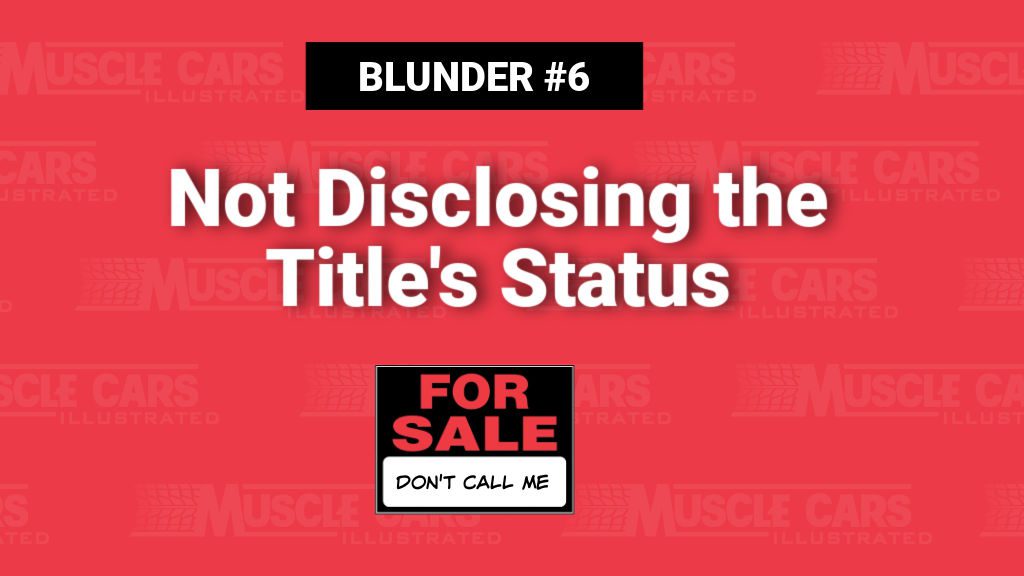
Not Disclosing The Title’s Status
You must answer three crucial questions related to the vehicle’s title to instill confidence that a deal can happen smoothly and quickly if you and the buyer strike a deal.
| Question | Notes |
|---|---|
| Does it have a clean title? | A clean title means the vehicle has never had any reported damage. Whatever the title’s status, it’s best to disclose it before someone shows up for a test drive. |
| Is the title in your name? | Having the title in your name signals to the buyer they are dealing with the person who has the authority to sell the vehicle and transfer ownership. |
| Do you have the title in hand? | Disclosing the title is in your immediate possession helps the buyer know whether or not there will be delays or if there are any issues. If your state doesn’t require a title, disclose it is a bill of sale transaction because your state doesn’t provide titles. |
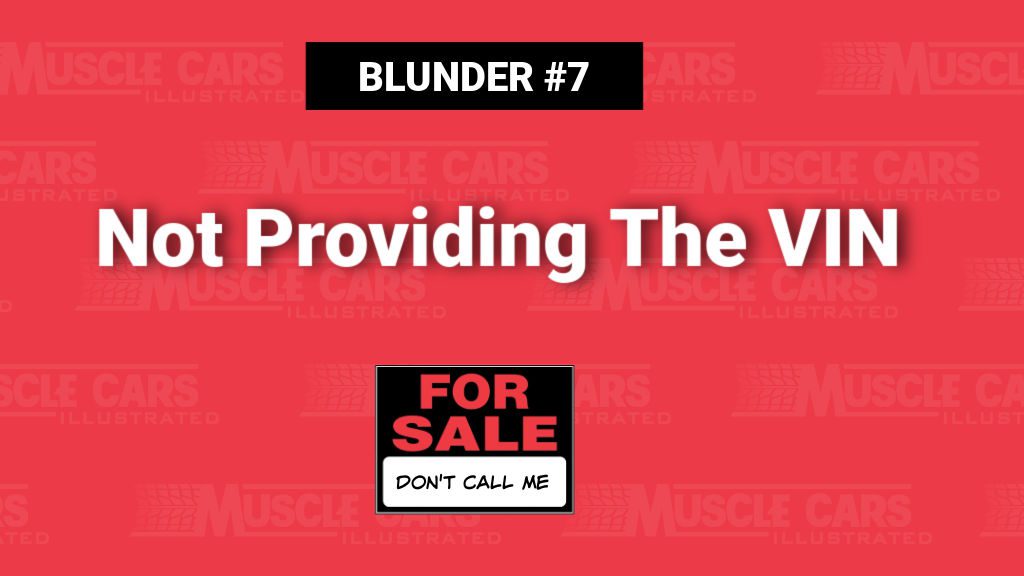
Not Providing The VIN
For some, providing a vehicle identification number (VIN) online might open them up to fraud and isn’t something they’re willing to do.
Fair enough.
However, providing at a minimum the first seven digits of the VIN will stop criminals in their tracks and still help prospective buyers.
It helps savvy buyers decode the most critical parts of the VIN to verify such details as the make, model year, engine, trim level, and more—depending on the manufacturer and model year.
It also helps buyers know that what you’re advertising is what they’re buying and that it isn’t a clone or tribute (unless you’ve already stated that in the classified ad).
If you wait to provide the entire VIN over the phone or in person, it’s still crucial for potential buyers to get this information as soon as possible.
Some buyers want the VIN to run a vehicle history report through services like VinData.com.
Vehicle History Report Services detail a vehicle’s recorded history, including title status, odometer readings, known accidents, state of registration, registration years, etc.
Suppose it’s a Pontiac or a Ford. Potential buyers can use third-party services like Pontiac Historical Society (PHS) or Marti Report to run a VIN report of factory options and vehicle details.
Suppose you don’t have a vehicle history report for your vehicle.
In that case, potential buyers in the know will want to obtain them before negotiating a deal on a purchase to ensure they know the history before making an offer.
At a minimum, provide the first seven digits of the VIN online and leave the rest for a phone call or an in-person test drive.
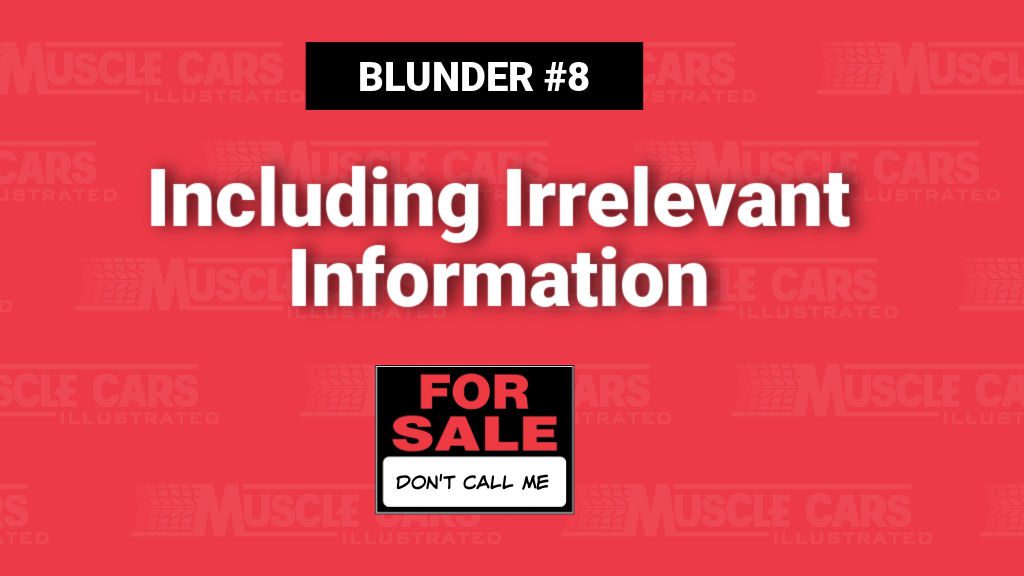
Including Irrelevant Information
I laugh every time I see a classified ad that states, “No scammers.” As if that alone was going to prevent a scammer from contacting you.
Yet, these same sellers don’t include relevant details that will help sell their vehicles. Instead, they include irrelevant information that doesn’t persuade anyone to take the next step.
Irrelevant information might include the history of muscle cars, connections to NASCAR, the number of trophies won, how many thumbs up you get, etc.
Remember: Your job is to sell your vehicle and your vehicle alone.
Avoid overstating factory specs or production numbers. Serious buyers will often know this information or look it up before making contact.
Instead, focus on the details outlined in this article that help you sell your particular vehicle. These tips will help create a stronger listing, more so than including details anyone can Google.
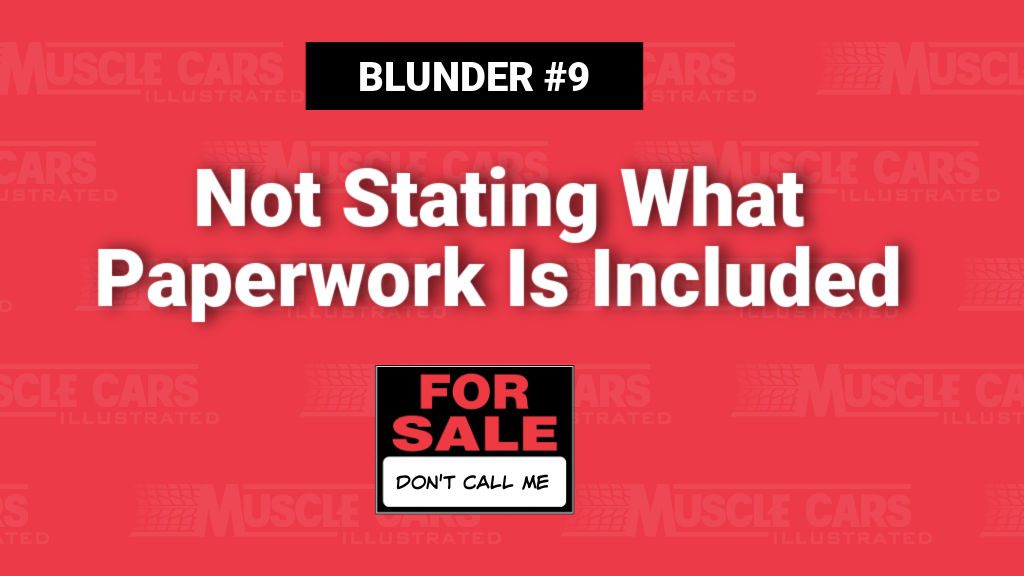
Not Stating What Paperwork Is Available
While it’s true that not everyone cares about documentation, it can undoubtedly help justify your asking price and help attract more serious buyers.
Having an original dealer invoice, window sticker, warranty card, or build sheet is highly sought after and desirable for classic muscle cars.
In fact, these are the most valuable documents one can possess because they provide provenance for the vehicle—the vehicle’s origins.
Having a bill of sale or previous owner’s registrations is also desirable. You can use them to potentially track down previous owners to learn about the vehicle’s history.
Service records are also highly desirable but not as valuable as documentation from the dealer or factory. However, they will help you determine what’s been repaired, by whom, and when.
In any case, list the paperwork you do have. If you don’t have any records or documents, state that instead. Either way, it’s important to put this information in your listing.
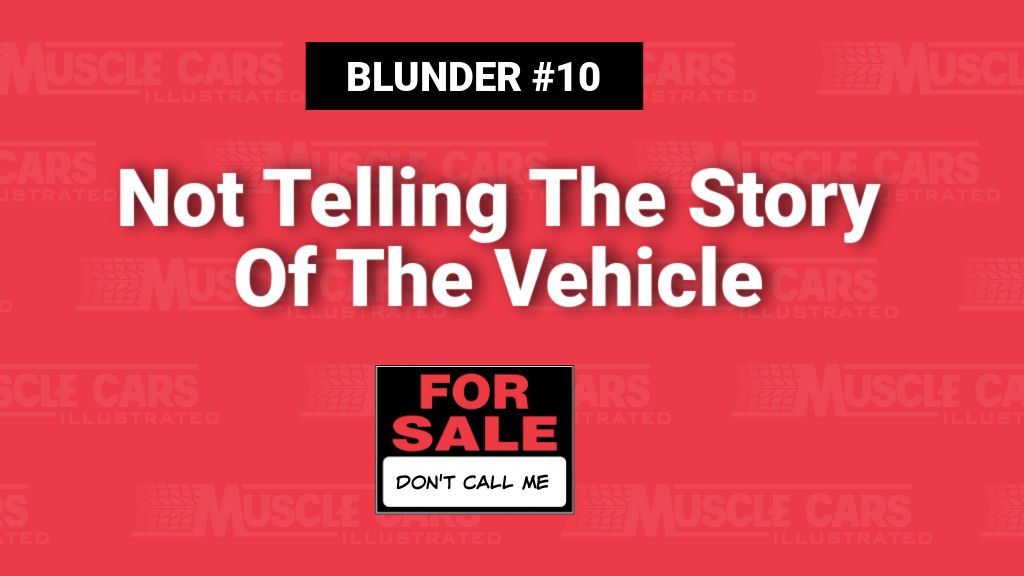
Not Telling The Story Of The Vehicle
Telling the story of your classic muscle car is critical, especially if details connect your vehicle to drag racing, NASCAR, or a renowned specialty dealer that originally sold your car.
However, as stated above, these story details must pertain to your specific vehicle, not the model line at large.
For example, a 1968 Ford Torino has ties to NASCAR because Ford produced Torino’s that actually raced at Daytona. However, not all Torino’s produced by Ford raced at Daytona.
See the difference?
If you have one of the 1968 Ford Torinos that actually raced at Daytona, you’ll want to advertise it because it helps tell a unique story and builds value.
If your vehicle never touched the oval track in Flordia, don’t bother mentioning the NASCAR connection in your listing. Again, someone can Google that information.
While not all story details will be as extreme as NASCAR, there are still plenty of other details you can share that will help tell a compelling story or give it a hook.
Possible Story Details
- How many previous owners it has had.
- If you’re the original owner.
- If the vehicle has been family-owned since it was new.
- If you have photos from previous owners.
- How long you’ve owned it.
- How much of the original sheet metal is intact (the more the better).
- If it still wears the original paint.
- If it was originally purchased by a Vietnam Vet.
- If you have service records going back to when it was sold.
- An interesting story about the car that was told to you by a previous owner.
- Etc.
Sharing unique story details about your vehicle will help it stand out to prospective buyers, create interest, and help draw them in to close the sale.
Conclusion
Selling your classic muscle car isn’t as easy as uploading a few photos, a price, and a phone number. You need the right photos, information, and story to find your muscle car a good home.
Well, there you have ten classified ad blunders to avoid when selling a muscle car. What would you add to this list? Did we miss something? Let us know below!
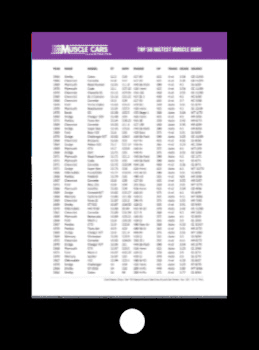
Get The Top 50 Fastest Muscle Cars chart. Includes year, model, engine, 1/4 mile times, and more—absolutely free!
Take Our Poll!
"*" indicates required fields

Ryan Wheaton
Ryan has owned muscle cars since 1986 and currently owns a 1972 Dodge Charger Rallye. He combines passion and experience to create engaging content for fellow muscle car enthusiasts. In 2018, he founded Muscle Cars Illustrated, authoring hundreds of articles on tips, history, and trends in the muscle car industry. He attends national car shows, auctions, and museums to stay current with the latest developments in the muscle car industry.Comments
Comments are closed.

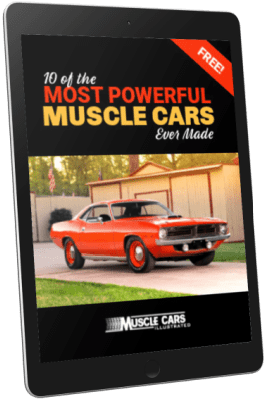
The VIN is my best investigative tool. Having all but the last few digits really helps. But I’m a data geek, so there’s that 😉
The under side pictures are the most important to me.